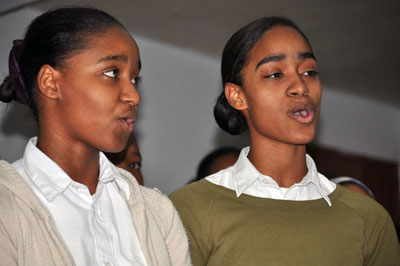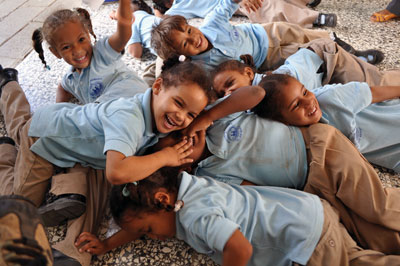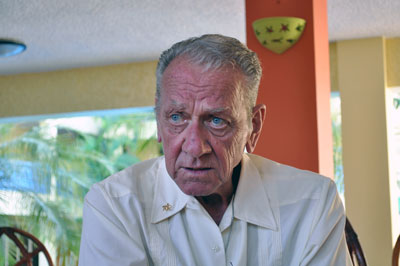By Joanne Ingram
Cronkite Borderlands Initiative
SANTO DOMINGO, Dominican Republic — Fate dealt teenagers Maria and Theresa Cajou a devastating hand in 2010. Their parents were killed in the Jan. 12 Haitian earthquake. Their school was destroyed. They lost all contact with friends and family.
Three days after the earthquake, the twins left their native Haiti and headed across the border into the Dominican Republic.
They were lucky. The girls, both 16, found refuge at the Dominica Orphanage and School in the capital city, where they are doing well.

Maria Cajou and her twin sister Theresa lost their parents and were brought to the Dominica Orphanage and School where, despite the tragedy, they are thriving. (Photo by Carie Gladding.)
But without proper documentation, the Cajous will hit a dead-end once they graduate.
“I know that the laws, our laws, won’t allow them to go to university without birth certificates,” said Dominica Orphanage founder Dominica Rosario. “I don’t even know what will happen with them when they finish.”
While education in the Dominican Republic is mandatory and free for children ages 5 through 14, regardless of their immigration status, many children do not continue to ninth grade because they lack a Dominican birth certificate or other official documentation that proves they are citizens.
“A lot of the kids, even the Dominicans, don’t have birth certificates,” said David Luther, executive director of the Instituto Dominicano de Desarrollo Integral, or Dominican Institute for Integral Development. “Consequently, after eighth grade they can’t . . . continue to go to school, they can’t take out a loan, they can’t vote. And that’s probably the best recipe for them to continue in a level of critical poverty.”
The Dominican Republic already has troubling numbers of people living in poverty and who lack literacy and a high school degree. Fewer than 10 percent of its 3.7 million children will graduate from high school, according to the organization Save the Children.
Many of the neediest children are orphans, some of them orphaned by last year’s earthquake in Haiti. In all, approximately 170,000 Haitian and Dominican orphans live in the Dominican Republic, according to UNICEF.
Making Education a Priority
Education advocates working in the country believe the government is not doing enough. They point out that only 2.3 percent of the nation’s gross domestic product is spent on education, even though the law calls for 4 percent of the nation’s GDP to go to schools. By comparison, the U.S. spends 5.4 percent of its GDP on education.
“For me it’s the biggest problem the country has,” said Kevin Manning, a business consultant who sits on the executive board of directors for the Dominican Republic Education and Mentoring (DREAM) Project, a nonprofit hoping to improve educational opportunities. “The poor are condemned to their poverty as a result.”
The Ministry of Education did not respond to calls and emails to discuss the country’s support for education. But Dominican President Leonel Fernandez’s administration has spoken about the need to improve the educational system.

The children at the Armando Rosenberg Home and School are able to receive an education because of charitable donations. (Photo by Carie Gladding.)
In March 2008, the Organization for Economic Cooperation and Development held its second Global Forum on Education in the Dominican Republic at Fernandez’s suggestion. During the opening session, Ligia Amada Melo de Cardona, state secretary for higher education, science and technology, “emphasized that President Fernandez sees education as the key for driving modernization and sustainable development in the Dominican Republic,” the OECD reported.
Cardona added that Fernandez wants to make the education system more “efficient and effective, in order to drive innovation and technological development.”
The Ministry of Education plans to build 41 more public schools, opening up 417 new classrooms before the 2011-2012 school year, according to Dominican news reports. The school expansion project is expected to cost $20 million.
Still, Manning insists that not enough is being done. Most classrooms lack desks and chairs, he said, and some teachers are barely literate. In other cases, teachers are in such short supply that classes are taught by the most advanced students, he said.
“Teaching has become the terrain of the lower classes in this country,” he said.
Jonathan Wunderlich, director of development for the DREAM Project in Cabarete on the country’s north coast, agreed that the “quality of the teachers is very low” in public schools.
Schools for the Poor
Originally from New York, Wunderlich came to the Dominican Republic almost eight years ago after spending several years teaching in a number of countries. He planned to write a novel but instead got involved with the DREAM Project, which has helped provide education to underprivileged Dominican children since 2002.

The Orchid Foundation was founded in 1983 by Harold Wooden after he visited the Dominican Republic and witnessed the devastating conditions of orphanage life. The foundation provides food and supplies to the Armando Rosenberg Home and School in Santo Domingo. (Photo by Carie Gladding.)
Teachers, parents and volunteers help run DREAM Centers located in six cities across the country. A total of nearly 500 students from ages 3 through 6 attend school in small classes. About 1,000 others, mostly older, participate in summer camps and youth development programs that teach computer literacy, music and health.
Most expenses are covered by U.S. donors, and no tuition is charged, Wunderlich said. Children who enroll must come from the community where the school is located and have a family member willing to volunteer for two weeks each year.
No legal documentation is required — a fact that has encouraged many local Haitian families to enroll their children.
“We very strongly believe that a quality education is the best way to lift all of these kids out of poverty,” Wunderlich said. “When we say ‘all of these kids,’ we also mean the Haitian kids.”
In Santo Domingo, Dominica Rosario also is doing what she can to educate the poorest of the Dominican Republic’s children, including those who are from Haiti.
Rosario said she and her brother, Alexis, grew up in an orphanage, where they received just one meal a day.
When her brother died in 2002, Rosario took over the school and has been running it by herself since. She also teaches two days a week at a college in San Pedro de Macoris, about an hour east of Santo Domingo.
The Dominica School relies on a combination of tuition and donations to operate — a dicey proposition in a poor global economy. Some longtime contributors have been unable to help in recent years, and the orphanage is in a precarious financial situation, Rosario said.
She has asked for financial help from the government but has received nothing so far. She does her best to understand and to be patient.
“They are focused on other things first,” she said. “I can see that they’re trying.”
Rosario said she increasingly relies on members of the local community for help. Some take children for overnight stays since there is not always enough room at the orphanage for everyone to sleep, she said.
Every day, she said she turns away three to four families who bring their children to live or to learn. Demand has grown since last year’s earthquake in Haiti.
“We have always had children from Haiti, but after the earthquake we got more children,” Rosario said. “We received about 30 children from the (Santo Domingo) hospital.”
All told, about 60 children, the youngest of them just 9 months old, live at the orphanage. About 200 attend the orphanage school.
Maria and Theresa Cajou are among the oldest residents, and they appear to have absorbed the lessons Rosario has taught them.
“School,” said Theresa through a translator, “is the future for children.”
